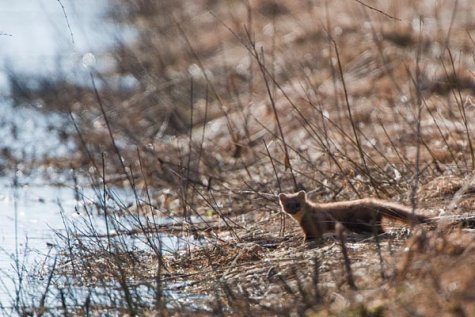Pine marten in winter furs
Photo: Arne Ader
Translation: Liis
Pine marten
Pine marten Metsnugis Martes martes
Stone marten; Beech marten Kivinugis Martes foina
Pine martens inhabit a wide variety of forests, preferring those with a dense undergrowth, but also areas with shrubs (hazel, juniper). Proximity to human settlements is no problem, martens prowl around in or even stay in the attics of living houses or in outbuildings. In forests tree hollows, or the nests of squirrels or larger birds are used as temporary refuges. When the waters begin to freeze martens that otherwise keep away from waters can be seen moving around in reed banks; at this time they can find a fair amount of extra food there.
The slim-bodied pine marten is comparable to a cat in size; its weight is just short of a couple of kilos. Pine martens are slightly larger than other mustelids and have longer legs. The fur is dense, airy, usually dark brown. The slender, strong and fluffy tail is around twenty centimetres. Ears are quite large and pointed. On the neck and chest a large yellowish or orange bib is conspicuous.
It usually leaves fuzzy oval-shaped twin tracks on snow. In winter the footsoles of the pine marten are furry, and the hind legs are set in the tracks of the forepaws. It hunts and searches for food mostly on the ground. The tracks may disappear at a tree; movements from tree to tree are very similar to the movements of squirrels. As a nocturnal animal it moves quite widely, up to ten kilometres in a night and day with good weather. In winter it rests briefly in temporary places and its activity area increases as it leads a solitary life.
A predator remains a predator, the pine marten can pursue and kill mountain hares larger than itself in winter. They harass squirrels in their winter nests, hunt gallinaceous birds and rodents on the ground, and carrion is a significant food supplement. Monitoring data suggest that Estonian forests are home to more than six thousand pine martens.
Human settlements and cultural landscapes are also inhabited by the slightly smaller stone marten. It is increasingly often encountered in western and north-western Estonia. The soles of the stone marten are hairless even in winter, thus the tracks are clearer. The bib, forked and reaching to the feet, is white or off-white.









